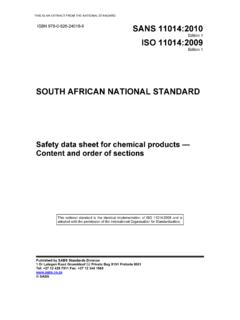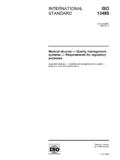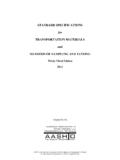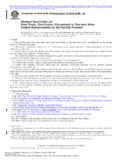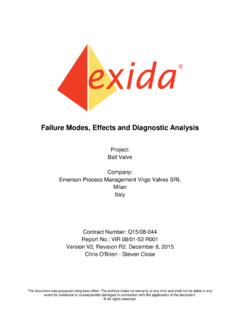Transcription of Petroleum Inspector Certification Programme Test …
1 Petroleum Inspector Certification Programme Test Questions English Language Sixth edition August 2016 BLANK PAGE (BACK OF COVER) i Petroleum Inspector Certification Programme Test Questions English Language Sixth edition August 2016 Copyright 2016 The International Federation of Inspection Agencies All rights reserved No part of this document may be reproduced by any means, or transmitted or translated into a machine language without the written permission of the International Federation of Inspection Agencies ii Disclaimers This document is designed to be used as part of the IFIA Petroleum Inspector Certification Programme .
2 IFIA makes no warranty, express or implied, that it is fit for any purpose whatsoever or to the absolute sufficiency of the material presented. It cannot be assumed that every procedure is covered. IFIA assumes no responsibility for any inaccuracies in reproduction or errors in interpretation of any authority. IFIA reserves the right to modify or amend this document without prior notification but assumes no responsibility to update or issue corrections. Reference is made in this document to the American Petroleum Institute s Manual of Petroleum Measurement Standards (API MPMS), to International Standards Organisation (ISO) documents and to the Energy Institute s Hydrocarbon Management (HM) documents (previously Institute of Petroleum Measurement Manual, IP PMM).
3 These are copyright publications and questions or requests for information regarding these standards should be addressed to the respective organisation. UK First edition published February 2003 International First edition published October 2004 (fully compatible) International Second edition published January 2008 International Third edition published March 2009 (questions fully compatible) International Fourth edition published November 2012 Fifth edition published April 2016 (replaces International Fourth edition and Americas version Sixth edition ) Sixth edition published August 2016 question revised iii Introduction This document has been produced by the IFIA Petroleum and Petrochemical Committee to represent a basic body of knowledge which is expected of a Petroleum Inspector .
4 A sub-set of 100 of these questions will be used to form the examination which must be passed as part of the qualification Certified Inspector of Petroleum . The pass level is 75%. Candidates must have completed a minimum of 6 months working as a Petroleum Inspector and a specified Programme of field and classroom training. This is detailed in the IFIA Petroleum Inspector Training Requirements List and must be fully documented in the employer s internal training records. The Petroleum Inspector Certification Programme is an international Programme and the qualification is international and transferable.
5 The guidelines governing the Petroleum Inspector Certification Programme are determined by the IFIA Petroleum and Petrochemical Committee. The Programme has been approved by US Customs and by Energy Institute committee representatives from a number of major oil companies and is recognised as key indicator of an Inspector s competence. This fifth edition of the test questions includes metric and traditional units with alternate content in square brackets; [ ]. Figures are not equivalent. To obtain a copy of the guidelines or for any other enquiries concerning the Programme please visit the website at Further contact details are available there.
6 Iv BLANK PAGE v Contents Section 1 Calculations Section 2 Definitions Section 3 Loss Control Section 4 Marine Measurement Section 5 Safety Section 6 Sampling Section 7 Tank Gauging Section 8 Temperature Determination Section 9 Metering Section 10 Ethics iv BLANK PAGEC alculations Page 1 IFIA Petroleum and Petrochemical Committee Sixth edition August 2016 SECTION 1 CALCULATIONS As the density of a material increases, what happens to the API Gravity? a. It becomes higher * b. It becomes lower c. It does not change d. Answers a., b. and c. are all wrong Density of any substance is the ratio of its mass to its volume, usually at a specified temperature.
7 Relative Density is the ratio of the density of a substance at a specified temperature to the density of what other substance? a. Pure ethanol at the specified temperature b. Acetone at the specified temperature * c. Pure water at the specified temperature d. Vegetable oil at a specified temperature When a capacity table indicates a reference API Gravity and an API Gravity correction per barrel variance for a shore tank, what data must be available to calculate a floating roof correction? a. Weight of the roof only b. API Gravity of the contents at 60 F ; API Gravity for which the capacity table was calculated; correction in barrels for each degree of difference in API Gravity c.
8 Observed API Gravity of the contents; Weight of the roof; correction in barrels for each degree of difference in API Gravity * d. Observed API Gravity of the contents; API Gravity for which the capacity table was calculated; correction in barrels for each degree of difference in API Gravity When calculating the Gross Standard Volume (GSV) in a shore tank at a pressure of 1 atmosphere, the factor 'Ctpl' / 'CTL' is the same as which other factor? a. Vessel Experience Factor (VEF) * b. Volume Correction Factor (VCF) c. Weight Correction Factor (WCF) d. Voyage Analysis Report (VAR) Page 2 Calculations IFIA Petroleum and Petrochemical Committee Sixth edition August 2016 If a cargo does not contain S&W, the Gross Standard Volume and the Net Standard Volume are the same.
9 * a. True b. False c. d. For a crude oil cargo, what information does the formula GOV x VCF give? * a. GSV (Gross Standard Volume) b. NSV (Net Standard Volume) c. TCV (Total Calculated Volume) d. VCF (Volume Correction Factor) The Total Calculated Volume is equal to the Gross Standard Volume plus what? * a. Free water b. S&W c. Roof Correction d. Free Water and S&W For a trim correction to apply, which of the following conditions must exist? a. Vessel must be down by the stern b. Liquid may not contact the forward bulkhead * c. Liquid must touch all four bulkheads d.
10 Conditions a., b. and c. must all exist What is the equation used to calculate a vessel's 'trim factor'? * a. Trim divided by the length between perpendiculars b. Trim divided by the vessel's width c. Trim divided by the tank length d. Tank length divided by the length between perpendiculars Calculations Page 3 IFIA Petroleum and Petrochemical Committee Sixth edition August 2016 What must roof corrections be based on? * a. The density or API gravity at the observed temperature of the oil in the tank b. The density or API gravity at standard temperature of the oil in the tank c. The barrels per inch calculated from the tank capacity table d.



